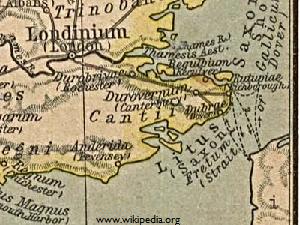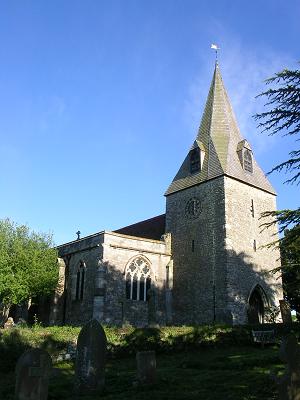A Brief History of East Farleigh - Farleighs' History Society
Ancient to Roman Times

The Medway Valley has been occupied from ancient times and many palaeolithic tools have been found in Coxheath. Quarry Wood camp (once part of East Farleigh), in Loose, was a late Iron Age oppidum, or proto-town constructed around 40BC which would have served the typically dispersed villages and farmsteads of these times although no Iron Age roundhouses have been discovered in the parish, to date.
In Roman times, villas and temples were spread along the banks of the Medway and archaeological investigation is currently underway on what appears to be a dwelling and several farm buildings just off Lower Road. In Roman times, the quarry off Dean Street produced ragstone for London's buildings and walls as well as the shore forts of Reculver and Richborough and it has been suggested that the Roman farm in East Farleigh provided food for the workers in the quarry. Roman pottery and coins have been discovered in several sites throughout the village and two cremation urns have been found in Gallants Lane.
Medieval Period to English Civil War

In 961, East Farleigh manor was given by Queen Ediva, the mother of king Edmund, to Christ church Canterbury. Following the conquest, the manor is listed in the Domesday Book and was held by Bishop Odo of Bayeaux (also Archbishop of Canterbury), William's half-brother. Mention is made of 110 villagers and slaves, (but probably only counts the men of the parish), 4 mills, 6 fisheries producing 1200 eels pa, woodland for 145 pigs and a church. In the Domesday Book the village is called Ferlaga; usually translated from Saxon as “the way of the passage” (over the river) or from Gaelic as a “clearing in the woods (or grass, or alder)”. By 1300 it is referred to as Fearnlega in the Book of the Church of Rochester and on a map of 1575 as East Farly.
In about 1120, The Normans rebuilt the Saxon church; all that remains of the original is a little tufa stonework on the outside of the north-west corner. The tower was added in the 12th century and the aisles in 1835.
The medieval bridge is said to be the finest in Southern England. Although it is unsure exactly when it was built, the earliest known mention of the bridge dates from 1324. General Fairfax crossed Farleigh Bridge on 1st June 1648 to outflank the Earl of Norwich whose Royalist troops were camped on Penenden Heath. Significant numbers of cannon balls have been recovered from the area surrounding the bridge together with a handgun (now lost). Trenches dug on the Barming side of the bridge produced many bones of men and horses as well as a canon which was kept outside the Victory pub for many years. It is clear that there was Royalist opposition at the bridge but Fairfax reported the crossing was relatively easy. The subsequent Battle of Maidstone was one of the fiercest fought of the civil war starting at 7pm and finishing at midnight in St Faith's churchyard with the Royalist surrender.
19th and 20th Centuries

The village's first “school” was in the church porch. Around 1820, a National School was established next to the Old Vicarage where it remained until 1846. As a result of a public subscription raised by Rev. Henry Wilberforce, a new school was built next to the church (now the church hall). The school was re-sited in 1930 to its present location but burnt to the ground in 1953. As a temporary measure the school moved back to the Victorian school house until the new brick-built school was finished in 1956.
April 2009
Duncan Spencer
Chairman
Farleighs' History Society
East Farleigh Village Fete
The date has been Set!
Sat 29th June 2024
We now need your help!
Click for more Details...

